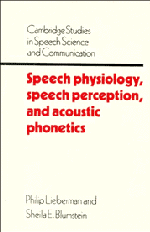Book contents
- Frontmatter
- Contents
- List of figures
- Preface
- Acknowledgements
- 1 Introduction
- 2 A qualitative introduction to the physiology of speech
- 3 Basic acoustics
- 4 Source–filter theory of speech production
- 5 Speech analysis
- 6 Anatomy and physiology of speech production
- 7 Speech synthesis and speech perception
- 8 Phonetic theories
- 9 Some current topics in speech research
- 10 Acoustic correlates of speech sounds
- Bibliography
- Index
7 - Speech synthesis and speech perception
Published online by Cambridge University Press: 05 June 2012
- Frontmatter
- Contents
- List of figures
- Preface
- Acknowledgements
- 1 Introduction
- 2 A qualitative introduction to the physiology of speech
- 3 Basic acoustics
- 4 Source–filter theory of speech production
- 5 Speech analysis
- 6 Anatomy and physiology of speech production
- 7 Speech synthesis and speech perception
- 8 Phonetic theories
- 9 Some current topics in speech research
- 10 Acoustic correlates of speech sounds
- Bibliography
- Index
Summary
Vocoder synthesizers
The pace of research on the perception of speech corresponds in a meaningful way with the development of speech synthesizers. The initial impetus for work on speech synthesis was commercial. In the 1930s Dudley and his colleagues at Bell Telephone Laboratories developed the Vocoder (Dudley, 1936, 1939). The Vocoder is a device that first analyzes a speech signal by means of a set of electronic filters and a fundamental frequency extracting device. The electronic filters derive an approximation of the spectrum of the speech signal as a function of time while the fundamental frequency extractor simultaneously derives the fundamental frequency, or in the case of – voiced sounds indicates a noiselike source excitation. The electrical signals derived by the spectrum channels and the fundamental frequency extractor are then transmitted to a synthesizer in which the acoustic signal is reconstructed.
The diagram in Figure 7.1 illustrates a Vocoder system. The signal from the fundamental frequency extractor (the pitch channel) is used to drive a pulse generator (relaxation oscillator) in the Vocoder synthesizer. The output of the Vocoder synthesizer thus has the same periodicity as the input signal. The Vocoder was developed to serve as a speech transmission system that would reduce the frequency bandwidth that is necessary to transmit a speech signal. Although the Vocoder equipment might be expensive, it would more than pay for itself if it allowed the telephone company to “squeeze” twice as many messages into the frequency channel of a transoceanic telephone cable, for example.
- Type
- Chapter
- Information
- Speech Physiology, Speech Perception, and Acoustic Phonetics , pp. 140 - 161Publisher: Cambridge University PressPrint publication year: 1988

